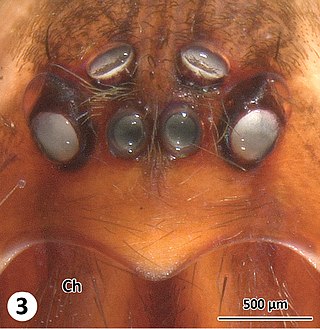
The family Dipluridae, known as curtain-web spiders are a group of spiders in the infraorder Mygalomorphae, that have two pairs of booklungs, and chelicerae (fangs) that move up and down in a stabbing motion. A number of genera, including that of the Sydney funnel-web spider (Atrax), used to be classified in this family but have now been moved to Atracidae.

Hexathelidae is a family of mygalomorph spiders. It is one of a number of families and genera of spiders known as tunnelweb or funnel-web spiders. In 2018, the family was substantially reduced in size by genera being moved to three separate families: Atracidae, Macrothelidae and Porrhothelidae.

Actinopus is a genus of mygalomorph spiders in the family Actinopodidae. It was first described by Josef Anton Maximilian Perty in 1833 from the type species Actinopus tarsalis found in Brazil. The name is derived from Greek actin- "ray, beam" and pous "foot". It is a senior synonym of Aussereria, Closterochilus, Pachyloscelis, and Theragretes.
Plesiolena is a small genus of South American mygalomorph spiders in the family Actinopodidae. It was first described by Pablo A. Goloboff and Norman I. Platnick in 1987, and it has only been found in Chile. The name is a combination of "plesiomorphy" and the genus Missulena. As of November 2021 it contains only 2 species: P. bonneti and P. jorgelina.

Migidae, also known as tree trapdoor spiders, is a family of spiders with about 100 species in eleven genera. They are small to large spiders with little to no hair and build burrows with a trapdoor. Some species live in tree fern stems. They have a Gondwanan distribution, found almost exclusively on the Southern Hemisphere, occurring in South America, Africa, Madagascar, Australia, New Zealand and New Caledonia.

Austrochilidae is a small spider family with nine species in two genera. Austrochilus and Thaida are endemic to the Andean forest of central and southern Chile and adjacent Argentina.

Neocteniza is a genus of armored trapdoor spiders that was first described by Reginald Innes Pocock in 1895. Originally placed with the Actinopodidae, it was moved to the Idiopidae in 1985.

Caponiidae is a family of ecribellate haplogyne spiders that are unusual in a number of ways. They differ from other spiders in lacking book lungs and having the posterior median spinnerets anteriorly displaced to form a transverse row with the anterior lateral spinnerets. Most species have only two eyes, which is also unusual among spiders. A few species of Caponiidae variously have four, six or eight eyes. In some species the number of eyes will increase when the spiderling changes its skin as it grows towards adulthood.
Scotinoecus is a genus of South American funnel-web spiders that was first described by Eugène Louis Simon in 1892. Originally placed with the curtain web spiders, it was moved to the Hexathelidae in 1980.
Goloboffia is a genus of spiders in the family Migidae. It was first described in 2001 by Griswold and Ledford to accommodate the single species Goloboffia vellardi, found in Chile. In 2019, more species were described. As of September 2020, five species were accepted:
Hermacha is a genus of mygalomorphae spiders in the family Entypesidae. It was first described by Eugène Louis Simon in 1889. Originally placed with the Ctenizidae, it was transferred to the funnel-web trapdoor spiders in 1985, then to the Entypesidae in 2020. It is a senior synonym of Damarchodes and Hermachola.
Vilchura is a genus of spiders in the family Euagridae. It was first described in 2017 by Ríos-Tamayo & Goloboff. As of 2017, it contains only one species, Vilchura calderoni, from Chile.
Goloboffia vellardi is a species of spider in the family Migidae, found in Chile. Initially described by Zapfe in 1961 in the genus Migas, Griswold and Ledford moved it to their new genus Goloboffia in 2001, where it was initially the only species. In 2019, more species were described.
Euagridae is a family of mygalomorph spiders. The group was first described as a tribe in 1979 by Robert Raven, who in 1985 elevated it to a subfamily. In 2020, Opatova et al. elevated it further to a family.






